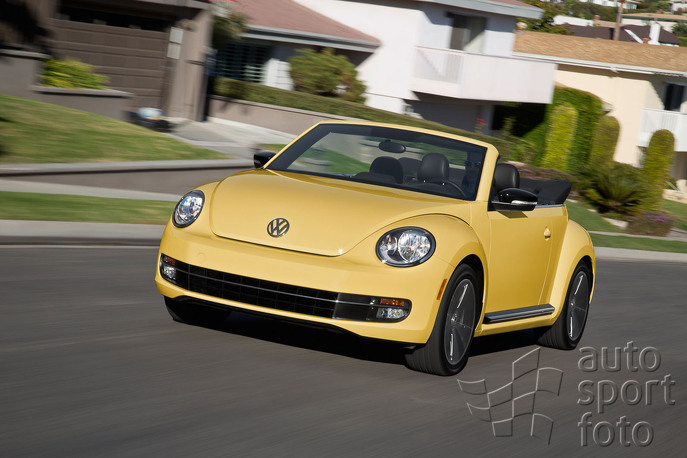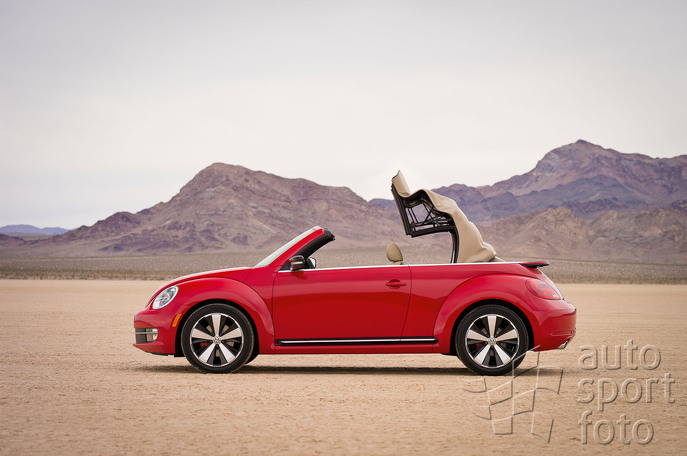The new Beetle Cabriolet – more powerful, confident and fuel-efficient

- Agile: new Volkswagen convertible comprehensively engineered for sportiness
- Open: standard power soft top is fully stowed in 9.5 seconds (up to 50 km/h)
In a world premiere at the Los Angeles Auto Show, Volkswagen is presenting the new Beetle Cabriolet. After the original Beetle Cabriolet and New Beetle Cabriolet, this is the third generation of an automobile that enjoys cult status nearly everywhere in the world. The new Beetle Cabriolet is now larger. Plus it's more powerful, sporty and also more fuel-efficient. The visual impression is of a car that is longer, wider and has a lower roofline, making its proportions look more dynamic. Aside from its performance data and fuel economy figures, the most important value of a cabriolet is the time it takes to stow the soft top. In the Beetle Cabriolet, this is accomplished in just 9.5 seconds thanks to a standard electro-hydraulic drive. It can even be opened while driving up to a speed of 31 mph (50 km/h). When stowed, the roof folds together compactly behind the rear seats, optimising the view to the rear. The fabric soft top of the Beetle Cabriolet can be raised in 11.0 seconds; the extra 1.5 seconds is accounted for by the amount of time the electro-hydraulic drive takes to latch the roof automatically to the windscreen frame.

Icons. The new Beetle Cabriolet demonstrates the great potential of what is certainly the most familiar design in automotive history - the design of the Beetle. As a convertible, it became one of the world's first automobiles to break free of class boundaries back in the middle of the last century; 331,847 units were built over a period of 32 years. The Beetle design experienced a renaissance with the New Beetle. That open-top version was the "Flower power convertible of a new era"; in eight years a substantial 234,619 New Beetle Cabriolet cars were built. The secret of its success: the New Beetle Cabriolet was not simply a copy of the original Beetle Cabriolet - instead, designers re-interpreted the forms of the car body and further developed them.

And that is how the team led by Klaus Bischoff, Head of Design for the Volkswagen Brand, approached the design of the new Beetle Cabriolet. Bischoff: "Retro is not our thing; we are always looking forward. The Beetle Cabriolet was designed to have a more powerful and masculine stance on the road. And we have achieved this goal."

Dimensions. At 4,278 mm, the new cabriolet is 152 mm longer than the New Beetle. The car also grew 84 mm in width (1,808 mm, without door mirrors). Since the convertible was simultaneously made 29 mm lower, to a height of 1,473 mm, the Beetle shows considerably more dynamism and road presence - simply because of these proportions. The gain in length benefits interior space and boot capacity. And even when the soft top is down, it hardly limits cargo space; when compared to the New Beetle, its cargo capacity was increased by 24 litres to 225 litres. Unlike in the New Beetle Cabriolet, the rear bench seat can now be folded down, thanks to a newly developed rollover protection system. The standard rollover protection system pops up from behind the rear head restraints within milliseconds when a predefined lateral acceleration or vehicle tilt value is exceeded.

Spacious feeling. The new dimensions along with the windscreen frame that has been shifted significantly towards the rear thereby modifying the roof contour - give the two rear passengers greater headroom - 12 mm more to be exact. The Beetle Cabriolet gives the driver and front passenger an entirely new feeling of space as well. As in the hard top version, the convertible's completely remastered ergonomics create an interior that matches the dynamism of the exterior. In the new cabriolet - as in the New Beetle Cabriolet and original Beetle Cabriolet - "open" really means "open", and there is no long windscreen to stand in the way of a pure cabriolet feeling.

US versions. In the USA, the new Beetle Cabriolet is available with a 103 kW TDI (140 PS) and a 147 kW TSI (200 PS), which are also offered in Europe, as well as a 125 kW five-cylinder engine (MPI) that was specially developed for the American market. The latter is offered with a 6-speed torque-converter automatic; a Volkswagen 6-speed dual-clutch gearbox (DSG) is available as an option for the TSI and TDI.

Extremely efficient (EPA fuel economy). In the USA, as elsewhere in the world, the efficiency of engines continues to play an increasingly important role. In light of this, as a TDI (0-60 mph in 9.2 s) the Beetle will be positioned as one of the most fuel-efficient convertibles on the US market with fuel economy values of 32 mpg (combined) and 41 mpg (Highway). Fuel economy values for the DSG version have not yet been determined. The 147 kW TSI (0-60 mph in 6.9 s), with a manual gearbox, attains 24 mpg (combined) and 30 mpg (Highway); with DSG the combined fuel economy value is nearly identical (24 and 29 mpg), which speaks volumes for the efficiency of the dual-clutch gearbox. The 125 kW engine with its 6-speed au-tomatic also attains a good 23 mpg (27 mpg Highway).

European versions. In Europe, Volkswagen will offer the Cabriolet exclusively with direct-injection four-cylinder turbo engines. The three TSI (petrol) engines produce 77 kW / 105 PS, 118 kW / 160 PS and 147 kW / 200 PS, while the two TDI (diesel) engines develop 77 kW / 105 PS and 103 kW / 140 PS. Either of these engines may be paired with an optional Volkswagen-developed dual-clutch gearbox (6- or 7-speed DSG) - a first in this class, and not just at Volkswagen. In Europe, the two engines that are also offered in the USA attain fuel consumption values of 5.1 l/100 km (140 PS TDI, manual gearbox), 7.6 l/100 (200 PS TSI with manual gearbox) and 7.9 l/100 (200 PS TSI with DSG).

Impressive features. Whether in America or Europe - standard equipment always includes the ESP electronic stabilisation pro-gramme including brake assist and hill hold feature, a network of airbags including side curtain airbags and automatically actuating rollover protection. Optional features that are being offered in a Beetle Cabriolet for the first time include bi-xenon headlights, a keyless engine starting and locking system (Keyless Access), ambience lighting, Fender sound system (400 Watts), automatic climate control, radio-navigation system with touchscreen and hard drive, auxiliary instruments on the instrument panel (chronometer, oil temperature, charge pressure) and alloy wheels in 18- and 19-inch formats.

Customisation. Similar to the hard-top Beetle with its steel or panoramic sunroof, the Cabriolet will also be available in three equipment versions (USA: "2.5 L", "Turbo", "TDI"; Europe: "Beetle", "Design", "Sport"). In addition, Volkswagen has conceptualised three special edition models for the open-top Beetle at its market launch: the stylish "50s Edition", the cool "60s Edition" and the elegant "70s Edition." Each of the three editions reflects the style of a decade - in tribute to the legendary Beetle Cabriolet. The "50s Edition", for example, offers such features as 17-inch "Circle Black" alloy wheels, chrome door mirrors, a black soft top and "Monochrome Black" paint. The "60s Edition" model was inspired by the style of the 1960s with high-end sport seats in black-blue "Vienna" leather and either "Denim Blue" or "Candy White" body colour in combination with a black soft top,. The "70s Edition" aims for elegance - with "Toffee Brown Metallic" or "Platinum Grey Metallic" exterior colours that harmonise well with the beige-coloured soft top and leather sport seats. The new Beetle Convertible launches on the USA market at the end of November 2012; in Europe, the Volkswagen launches in February 2013.

Notes:
TDI, TSI, DSG and Twincharger are registered trademarks of Volkswagen AG or other companies of the Volkswagen Group in Germany and other countries.
Features and technical data apply to models offered in the USA . They may differ in other countries.
Photogallery: Volkswagen Beetle Convertible
Diskusia k článku
Najnovšie galérie
































 Toni
Toni 
 Jan
Jan 
 Emil
Emil  Klaudia
Klaudia 
 Miloš
Miloš